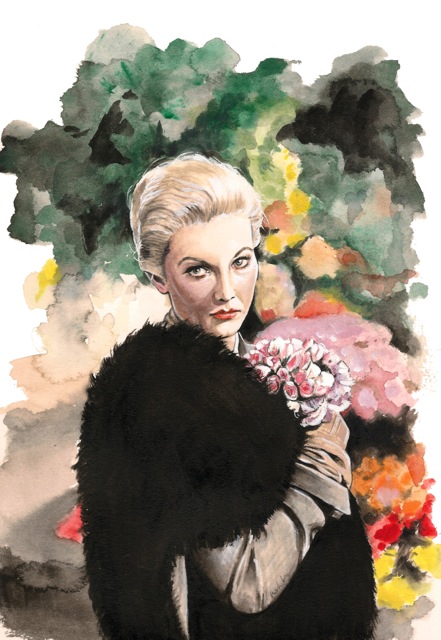It’s Alfred Hitchcock month for the monthly web magazine Bright Wall/Dark Room, of which we are pleased to feature an except from here at RogerEbert.com. Along with this essay by Lauren Wilford on “Vertigo,” the BW/DR team analyze from a distinct personal perspective the likes of “
Notorious,” “Psycho,” “The Birds,” “Rope,” “The 39 Steps,” “The Lodger” and “Strangers on a Train.” Read more excerpts here and you can buy the magazine on your iPhone and iPad here, or sign up for the web-based online version here. The illustration above is by Brianna Ashby.
Most films with a twist ending beg to be started up again immediately, rewatched with a vigilant eye. “Vertigo,” somehow, doesn’t. It invites repeat viewings, to be sure. Martin Scorsese has described “being drawn and drawn to the picture, like being drawn into […] a very beautiful, comfortable, almost nightmarish obsession.” But we don’t rewatch “Vertigo” for clues; we watch to fall into its pull all over again. Most of the iconic, hypnotic images of “Vertigo” are images of Kim Novak as Madeleine: now in a flower shop, now falling into the San Francisco Bay, now awash in eerie green light. The film is about a man obsessed, and so the camera stalks what he stalks, wants what he wants. It doesn’t matter that we learn two-thirds of the way through that “Madeleine” was a sham, that her blonde chignon and lost gaze were fictions meant to entrap Jimmy Stewart’s Scottie. We don’t care if she’s a fake. To fire up “Vertigo” is to be struck anew by Kim Novak in that green dress, to trail her in the car, to run up the bell tower after her.
You can do this many times over and never engage in the thought experiment that I’m about to propose: to experience “Vertigo” through the eyes of its female lead, Judy Barton. What was once a mystery becomes a horror film, a story of anxiety so profound that it approaches body horror.
A traditional plot summary would tell you that “Vertigo” is the story of John “Scottie” Ferguson, a former detective who leaves the force after a traumatic incident where his partner fell to his death. An old colleague, Gavin Elster, convinces Scottie to take on a private assignment to trail his wife, Madeleine. Elster explains to Scottie that Madeleine has been going into trances and behaving erratically, and that she appears to be possessed by the spirit of her suicidal great-grandmother, Carlotta Valdez. Scottie becomes infatuated with Madeleine and tries to keep her from harm, but his vertigo prevents him from following her up the bell tower where she jumps to her death. After being released from a mental institution, Scottie finds a young woman who looks much like Madeleine, and becomes obsessed with making her over into the image of his late love. This young woman is Judy Barton. We learn that Gavin Elster chose Judy to play the role of his wife in order to lure Scottie into witnessing his wife’s “suicide”— in fact a murder. Judy plays along with Scottie’s makeover because she loves him, but eventually Scottie gets wise. He takes Judy back to the bell tower, forces her to admit her role in the murder and her affair with Elster, and conquers his fear of heights. Judy falls to her death, justice served.
Hitchcock tricks us into thinking of “Madeleine” and “Judy Barton” as different characters. “Vertigo’s” narration sticks so closely to Scottie’s perspective that we fall into the mystery every time. We meet ethereal blonde Madeleine, and then earthy redhead Judy, and never conflate them until Scottie’s climactic revelation. But it was always Judy Barton. This is her story.
One day, Judy Barton is spotted by a man named Gavin Elster. She walks down the street, surrounded by friends, looking good for no one in particular, unaware of the calculating male gaze that follows her. We actually get to see what this scene might have looked like—it’s reiterated for us in the second half of “Vertigo,” this time with Scottie standing in for Elster. The scene calls to mind the way that Hitchcock often found his female stars, his signature icy blondes. He saw Tippi Hedren in a commercial and snapped her up into a seven-year contract—and then proceeded to control her personal and professional life, down to the details of what she wore, ate, and drank.
In Judy, Elster recognizes raw material he can shape for his purposes. She bears a striking resemblance to his wife, a woman he wants to kill and replace. Judy is coached and directed. Judy’s clothes, hair, and manners are changed until she can pass for a mad Madeleine—both bewitched and bewitching. The first shot of “Vertigo” is an extreme close-up of the lipsticked lips and then mascara’ed eye of Judy, made up as Madeleine by Elster. The sinister spiraling melody of the opening theme accompanies one other sequence in the film: the makeover that Scottie forces Judy to undergo at the salon, again featuring extreme close-ups of her face. By the time Judy surrenders to Scottie’s aesthetic vision, she has made that blonde capitulation twice.
Somewhere in the course of her rehearsals, Judy becomes Elster’s lover. It might seem strange that a man would be attracted to a woman modeled after the wife he wants to kill, but control can be a powerful aphrodisiac. Judy, for her part, must have been flattered that such a formidable man singled her out. In offering her the role of Madeleine, he gave Judy the chance to perform a romantic, glamorous—and expensive— femininity to which Judy, a young Kansas-born transplant, never before had access. Later, playing Madeleine for Scottie, she would feel her seductive power over him. Now, playing Madeleine for Mr. Elster—for Gavin—Judy feels the frisson of knowing she ismore compelling than the wife she is imitating; she feels the guilty electricity of outshining the last woman.
At this point, the film’s plot begins to record Judy’s story. Gavin takes Judy out to a restaurant, where he has arranged for Scottie to see her in costume. When Scottie first lays eyes on her, Judy stops until she’s sure she feels his gaze. And the next day—as she buys her bouquet, visits Carlotta’s grave, and stares at Carlotta’s portrait in the museum—she can sense Scottie’s eyes on her the entire time. His stalking is not subtle. He does not keep a proper distance, but Judy performs an elegant trance that makes him feel like he is doing good detective work.
She puts on a brilliant show when she leads him to the edge of the San Francisco Bay, delicately dropping flowers into the water before her fall. The trap works; Scottie dives in and pulls her out, feeling urgent and masculine as her wet body drapes across his arms.
Of course, Judy was not actually drowning in the bay, and she never went unconscious. She keeps her eyes closed and controls her breathing as Scottie removes her clothes and places her under the covers. She feelswhere his hands and eyes linger. When he “wakes” her, Judy perfectly presents as the doe-eyed Madeleine, damp-haired and serenely bewildered. Her voice is cool and musical, her lips lightly parted. She maintains just the right balance of seductive eye contact and demure glances at the floor. “I fell into the bay and you fished me out?” she asks, knowing exactly where to put the emphasis.
She knows how to make psychosis look feminine and attractive. Her “possession” by a suicidal spirit affords her lots of opportunities to gaze off into the distance, thrash gracefully, recount fairy-tale memories of a bygone world, fall into charming confusions, and to run, “lost,” into Scottie’s arms. “There’s so little that I know,” she coos, when Scottie presses her for detail on one of her “memories.” Scottie flatters himself that he can save her from her madness: “No one possesses you. You’re safe with me.”
Scottie is so fervent and focused in his passion for Madeleine that Judy is taken in. It’s breathtaking to be loved that hard. We can see Judy’s conflict in their kiss at the Spanish mission. Judy catches herself being swept up, wishing Madeleine were real so that this love could mean something.
She breaks away and runs up the steps of the bell tower, back to Gavin,the man who knows who she really is. But after the murder, Gavin leaves her.
“I cannot tell you exactly how much time passed, or how much happiness there was, but then, he threw her away…. You know, a man could do that in those days. They had the power, and the freedom…. There are many such stories.”
Judy starts over. She spends months recovering from the pain of reshaping herself for a man and then being discarded anyway. She slowly remembers how to be Judy.
Until Scottie finds her again. “You remind me of someone,” Scottie tells her. “I’ve heard that one before,” she says. And she has—but that time, she knew that Gavin meant, “You’re like someone I loved, but better.” This time, she knows that Scottie means, “You’re like someone I loved, but not quite.”
It’s dangerous to be compared to a partner’s former loves. At best, you’ll come out feeling superior; at worst, you can find yourself spiraling into obsessive research, trying to find out exactly where you stack up amid evidence of his taste. Knowing too much about what your partner likes can drive you mad—likefinding his browser history full of pornography starring actresses who look a lot like each other and nothing like you.
“Vertigo” takes this anxiety to a twisted new level. Judy knows exactly what Scottie’s ex was like, because she played her. She knows every inch of the painful distance between her real self and his ideal.
It is Judy’s fate to remind men of someone else.When Scottie admits that he is attracted to Judy because she reminds him of Madeleine, Judy replies, “It’s not very complimentary.” But she clings to the hope that she can convince him to love her as she is. When she decides to go out with Scottie as herself, she goes to her closet to pick a dress. She pulls out the gray suit she wore as Madeleine, seems to consider it— and then buries it in the back of the closet. She is tainted by the knowledge of his desires. There are no unrestrained, innocent choices anymore. She can put on that purple frock and pray he’ll be appeased, but that gray suit will haunt her. When a woman in the suit walks past their table at dinner, Scottie turns his head immediately, not even bothering to hide his attraction. Judy slumps, crestfallen. There’s no use.
“Vertigo” is a film about fake female madness and real male madness. Judy’s “possession” as Madeleine in the first half of the film is benign, compelling, and carefully controlled. On the contrary, Scottie’s obsession with turning Judy into Madeleine is unhinged and threatening. Judy’s chameleon allure is a double-edged sword. In the first half of the film, she puts on the Madeleine costume to gain power over Scottie. In the second half, Scottie exerts his power by demanding the Madeleine costume in exchange for his love. When you know how to realize a man’s fantasies—to tap into his precise desires—you might be surprised to find you’ve pushed yourself as a drug and created a demanding addict.
From Judy’s perspective, the second half of “Vertigo” constantly threatens to become a slasher movie. Her innocent attempts to win Scottie over—showing him pictures of her family, holding hands on a walk in the park—are strangled by Scottie’s sinister presence. He looms over her and withholds affection until she breaks. The scene where he forces her to buy the gray suit in the department store is harrowing. Judy runs to the corner of the room, reflected in a mirror. Scottie comes up behind her and towers over her. The shot shows two terrified Judys boxed in by two steely Scotties. “I don’t like it!” she whisper-screams. “We’ll take it,” he says to the clerk.
When Judy returns from her final makeover, Scottie is upset that she hasn’t adopted Madeleine’s hairdo. “We tried it. It just didn’t seem to suit me.” Judy makes a pitiful last stand, hoping that Scottie can love at least a small part of her natural self. He cannot. So she puts her hair up, and melts into the kiss that he has so long withheld. This is a woman so desperate for love that she is willing to let men use her body as a canvas upon which to paint their desires. This is the kind of woman you could pull into a murder plot by making her feel irresistible.
Once, someone loved me because of a girl he thought I was. He misread my thoughtfulness as romanticism and my love of nature as an innocent, feminine wonder. I had the luck and misfortune of finding out about a crush he had carried around for years, an intense, mystical sort of crush on a girl who sang in a local band. I developed my own obsession with her, because she served as a convenient key to my boyfriend’s taste. I scrolled through her Instagram and Facebook, collecting insights. Everything I learned about her was both pain and power to me. She was willowy and perfect, with long auburn hair and wide doll eyes. She wrote songs about the sea, and poems about clouds and leaves, and took pictures of her boot-clad feet turned in toward each other, and I felt like I had her number immediately. It made me feel superior and sophisticated to pin down the performative, artsy femininity that had attracted my boyfriend, but it did me no good in the game of securing his love. It took me a year and a half to pull myself out of the self-destructive loop of knowing too well what he wanted, becoming it, rebelling against it, and obsessing again. If you’re a good enough actress to be capable of self-deception, it’s not so very bad to be loved for who you aren’t.
At first I felt like Judy in the first half of “Vertigo”: I knew more than he did about what he wanted, so I kept his love and a measure of control. But the image I created for him, unwittingly and by degrees, trapped me. If I stepped outside of it, I risked losing him.
Judy ran up the bell tower the first time in part to escape the trap she had set for herself with Scottie. We saw her from below, from Scottie’s point of view, running away. When she is in the tower again at the climax of the film, we see her from above, pushed from behind by a menacing Scottie. He’s furious that another man had a hand in creating the image that captivated him, blind to his hypocrisy: “Did he train you? Did he rehearse you?” He throws her against the wall, punishing her for acting out the fantasy that he demanded. She can’t win. “I walked into danger, let you change me, because I loved you,” she cries, trying to make Scottie see that her deception was borne out of desperation.
But there is no redemption for a woman found guilty of exploiting a man’s desire. Scottie doesn’t like finding out that his fantasies are not unique, that they have been quantified and catered to. He felt justified in manipulating Judy because he was making her in the image of a woman who was “naturally” that way, “pure.” When Scottie finds that there was no such transcendentally attractive woman in the first place, he responds with violence—as if he were an obsessed john realizing that his prostitute was only playing a character for him. Judy’s crime as Madeleine was to make her calculated allure seem innate, essential, unaffected, and thus revealing Scottie as a dupe, emasculating him. Scottie may not have ended up killing Judy for that, but “Vertigo” surely does.
Scorsese sees “Vertigo” as “a very personal film” for Hitchcock. It’s difficult not to, with all the parallels between Scottie’s treatment of Madeleine/Judy and Hitchcock’s treatment of his cool blonde stars. The first and most natural experience of the film is through Scottie’s (and perhaps Hitchcock’s) eyes, a man obsessed by the image of a woman. But it is also a film about a particularly feminine anxiety— the anxiety of being beheld. Judy’s story in “Vertigo” is about how intoxicating it is to be intoxicating, the seduction of seducing.
Hitchcock may never have meant for the film to be seen this way, but “Vertigo” grants remarkable humanity to its female lead (in large part thanks to Kim Novak’s performance, which reveals astonishing layers when you follow the story through Judy’s eyes). It is crushing to watch how swiftly and fully the power balance shifts for Judy Barton. “Vertigo” tells the story of a woman who kills and is killed for her longing to be loved—forever cursed to remind men of someone, and finally destroyed for reminding a man of herself.











